| Union of Sino-Soviet Socialist Republics Союз Советско-Китайских Социалистических Республик 中苏社会主义共和国联盟 | |||||
|---|---|---|---|---|---|
| |||||
|
Motto: 'Пролетарии всех стран, объеденяйтесь! 世界工人团结一致! Workers of the world, unite! | |||||
|
Anthem: The Internationale | |||||
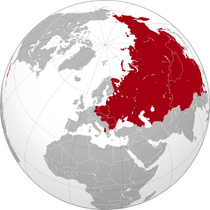 The Sino-Soviet Union as of 1988 including Warsaw Pact nations and other allied states | |||||
| Capital | Moscow and Beijing | ||||
| Largest city | Shanghai | ||||
| Official languages | Russian and Mandarin | ||||
| Demonym | Soviet | ||||
| Government | Single-party socialist federal republic | ||||
• Premier |
Vladimir Putin | ||||
• General Secretary |
Xi Jinping | ||||
• Chairman of the National People's Congress |
Zhang Dejiang | ||||
• Chairman of the Union of Nationalities |
Vyacheslav Volodin | ||||
| Legislature | National Assembly | ||||
| National People's Congress | |||||
| Union of Nationalities | |||||
| Formation | |||||
• Treaty of Creation |
December 30, 1922 | ||||
• Liberation of Manchuria |
August 20, 1945 | ||||
• Moscow-Beijing Friendship Treaty |
September 3, 1945 | ||||
• Unification |
March 31, 1946 | ||||
• Current constitution |
June 12, 1991 | ||||
| Area | |||||
• Total |
31,999,161 km2 (12,354,945 sq mi) | ||||
• Water (%) |
15.8% (including swamps) | ||||
| Population | |||||
• 2017 estimate |
1,719,402,253 | ||||
• 2012 census |
1,685,585,827 | ||||
• Density |
153.4/km2 (397.3/sq mi) | ||||
| GDP (PPP) | estimate | ||||
• Total |
$24.753 trillion | ||||
| Currency | Soviet Ruble | ||||
| Time zone | UTC | ||||
| Drives on the | right | ||||
The Sino-Soviet Union, officially the Union of Sino-Soviet Socialist Republics, is a sovereign socialist superstate located in Eurasia. At 31,999,161 kilometers, the Sino-Soviet Union is the largest country in the world by surface area, covering under one third of the human population and is the most populous state with over 1.7 billion people according to early 2017 estimates. Governed by the Communist Party of the Sino-Soviet Union, it exercises jurisdiction over 26 soviet republics from Eastern Europe to China and is the sole legal ruling party of the country. The Sino-Soviet Union is also the world's most ethnically diverse and multicultural nation in the world having over 30 ethnic and cultural groups in the entire country surpassing the United States in cultural diversity.
The Sino-Soviet Union was formed in the aftermath of World War II when the Soviet Union sent millions of troops into Manchuria to eliminate the dwindling Japanese forces and eventually liberated all of northeastern China. Afterwards, the Soviet troops aided the Chinese Communist Party and ended the Chinese Civil War with the elimination of the Nationalist government and the execution of Chiang Kai-shek and all nationalist leaders. Afterwards, CCP Chairman, Mao Zedong met with Soviet leader Joseph Stalin in Moscow and was willing to have China merge with the USSR into a single communist superstate believing that it would spread the ideology further around the world and would help with the reconstruction of China after the war. Stalin agreed and the Moscow-Beijing Friendship Treaty was signed on September 3rd, 1945 and the two nations merged at the end of March in 1946. After the two nations merged into one single union, the Cold War had already begun and the new nation quickly became the rival of the United States of America as the two nations sought to expand their ideology and spheres of influence around the world starting in 1951 with the invasion of Korea.
Tensions between the United States and the Sino-Soviet Union grew in the 1960s following the outbreak of the Second Indochina War where communist militants seized control over northern Vietnam and were supported by the USSSR against the American-backed Republic of Vietnam. In 1973, the Paris Peace Accords were signed and Vietnam was eventually divided and split into two nations. Throughout the 1970s and 80s, the United States began negotiations with the Sino-Soviet Union and tensions did lower despite hurdles in the road such as the Sino-Soviet invasion of Afghanistan in the 1979. By the 1990s, the Cold War was officially over and the two states ended ideological hostilities, but nationalist sentiments remained and the world remained divided between communism and western-backed capitalist states. In 1989, a major crisis erupted in the Eastern bloc in response to years of political repression and violation of the sovereignty of Warsaw Pact member states which resulted in a sieres of reforms throughout the era. Following the September 11 Attacks and the Moscow Metro Bombings, the US and USSSR began collaborating against radical Islam and age-old tensions further died down, but have resurfaced in recent years due to the actions of Vladimir Putin as the Premier of the union.
The Sino-Soviet Union is one of the two major superpowers in the world surpassing the United States on the global stage during the late 2000s. It now has the world's largest economy as a result of major free-market economic reforms and is the largest in both purchasing power and nominal GDP. The Sino-Soviet Union also possesses the world's largest standing army with the largest budget in the world and holds the largest stockpile of nuclear weapons as well. Due to its large size, the union has the largest oil and mining receives in the world and is a leading nation in science and technological development, a powerful cultural force, and the world's foremost military power. The USSSR is a member of the United Nations and serves as a pernament member of the United Nations Security Council, as well as the leading member of the Warsaw Pact, World Trade Organization, and the Collective Security Treaty Organization.
Geography
With an area of 31,999,161 square kilometres (12,354,945 sq mi), the Sino-Soviet Union is the world's largest country covering under one third of the world's total landmass. The European portion of the Russian SFSR and the Mandarin SFSR are two of the most densely populated portions of the entire country as well as being the primary economic and cultural hubs of the country. The countries borders extend from Central Asia all the way to the pacific coasts of the Chinese mainland and the eastern parts of Russia. Two thirds of the Sino-Soviet border was coastal and this made trading much easier for the nation in order to sustain its large population and size. The country has 11 time zones and five climate zones; tundra, taiga, desert, steppes and mountains.
History
The historical roots of the Sino-Soviet Union date back to the early 20th century during the founding of the original Soviet Union. Tsar Nicholas II ruled over the Russian Empire from 1894 until his forced abdication in 1917 in the aftermath of the February Revolution. The revolution resulted from Russia's disasterous involvement in World War I which lead to the deaths of millions of Russian soldiers and lead the empire to economic and military collapse resulting the downfall of the monarchy and the establishment of a short-lived provisional government which was overthrown in the October Revolution by the Bolsheviks lead by Vladimir Lenin. In December of 1922, the Soviet Union was officially established and would unify all of the republics in Eastern Europe and Central Asia.
World War II and foundation
In August of 1945 during the final days of World War II, the Soviet Union had deployed over 1.5 million troops across the southern border into northern China with the intent of eliminating the last remaining colonial holdings of the Japanese Empire. Japan had already been suffering a strain of defeats and heavy casualties both on the battlefield and back at home thanks to an American naval blockade of the mainland leaving Japanese troops in Manchuria and other colonial holdings in China all on their own and without support. The Soviets took advantage of this and deployed their troops down south with the intent to push the Japanese out of China for good. During this time, the Chinese Communist Party joined up with the Soviet forces and aided them in their fight against the Japanese. This would be a major contribution to the surrender of Japan to the United States with Emperor Hirihito fearing the communist threat of the Soviet Union. Japan eventually caved in and surrendered to the Allied Powers on September 2nd, 1945 officially ending World War II and had the United States and Soviet Union emerge on the world stage as the first two global superpowers in the modern era.

Soviet troops in Manchuria in August of 1945
The Soviet troops however, were not done their mission in China as they volunteered to help rebuild the broken and destroyed infanstructure and economy of China which near-collapsed as a result of the Chinese Civil War. In return, a communist state would be established and it would succeeded the Republic of China as a stronger and more powerful nation than before. A day after Japan's surrender, Mao Zedong had been meeting with Soviet leader, Joseph Stalin in Moscow during the last days of the war and the two negotiated over the possibility of having the two nations form a confederation which would make the communist states one, single, large superstate and it would help spread communsim all throughout the world. Stalin agreed to such terms and Soviet troops eventually helped the People's Liberation Army ultimately defeat the Chinese nationalists and had all nationalist leaders executed while some escaped off the coast to the neighboring island of Taiwan and established an independent republic there. By the start of 1946, China had gone under a program of reconstruction which was mostly supported by the Soviet Union as a means of rebuilding the battered and devestated country from the aftermath of the civil war which left six million Chinese dead, both military and civilian casualties. While the Soviets agreed to help rebuild China, the Chinese had to help rebuild the USSR from the aftermath of World War II, but the Chinese efforts didn't pay off.
In agreement with the Moscow-Beijing Friendship Treaty, the Soviet and Chinese governments were to help both countries in terms of social, economic, political, and military progress to stabilize and maintain the confederation between the two communist states. The Chinese however, were unable to pay their fair share and were far too reliant on Soviet aid and protection leading to Mao to propose the idea of both the USSR and China to merge into one country seeing how the Soviets were capable of rebuilding China and Mao believed that a single unified communist superstate would spread the ideology further across the world. Stalin eventually agreed to this and the Sino-Soviet Union was officially formed on March 31st, 1946 after the ratification and signing of the Treaty of Kiev.
Formation of the Chinese republics
After the Sino-Soviet Union was founded, the Soviet government was quickly reorganized and merged with the Chinese government that was established in Beijing. As part of the agreement, the capital of the new nation would be shared between the cities of Moscow and Beijing and would switch depending on the location of the new head of state. The two communist parties also merged into one single party as well and the office of the Premier was established to be the head of state while the head of government was handed over to the General Secretary of the Communist Party. Stalin took over as the first Premier of the Sino-Soviet Union and began to establish new Soviet socialist republics across the Chinese mainland based off of pre-existing Chinese provinces. In October of 1950, the neighboring state of Tibet was invaded and annexed into the Sino-Soviet Union and the Tibet SSR was quickly established afterwards. After the forced annexation of the country, the 14th Dalai Lama, Tenzin Gyasto, escaped the country and established a government-in exile across the border in India. Meanwhile back in Tibet, Stalin ordered all Sino-Soviet forces to use whatever means necessary to ensure a stable and compliant communist Tibet.
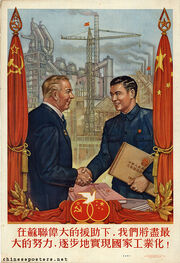
Chinese propaganda poster in 1950 celebrating the formation of the Sino-Soviet Union
Tibetan citizens marched in protest of the annexation and refused to cave into the communist regime knowing of their atrocities and anti-religious policies and persecution of all known religious groups in the country. This however, did not stop Stalin and the Great Tibetan massacre broke out as thousands of Tibetans were gunned down and executed as a means of forcing the country into submission. By the winter of 1951, Tibet officially surrendered while the remnants of its government remained hidden in exile across the border in India. News of the persecution made it to the United States and in response, President Harry Trueman ordered a naval blockade of Taiwan fearing a Sino-Soviet invasion of the small island and did the same thing to Japan and South Korea. In June of 1951, Sino-Soviet forces poured into North Korea and begna invading the south sparking the Korean war.
Cold War conflicts
Invasion of Korea
In October of 1951, North Korean forces poured into South Korea in an attempt to conquere the nation and annex it into the north's communist regime. At first, the North Koreans did well as they captured the south's capital, Seoul, and pushed them further towards the southern tip of the Korean Peninsula. Not wanting to lose another nation to communism and to prevent the Sino-Soviet Union from increasing in power, the United States sent in a force fo 50,000 men and helped push all North Korean troops out of South Korea. Lead by General Douglas McArthur, the American forces eventually began invading the north and pushed them all the way back towards the border with China. Fearing a continued American invasion into the Chinese mainland, Sino-Soviet troops were deployed and began to overrun and retake all of North Korea. American forces were overrun and were pushed back to Seoul where they managed to hold their ground and prevent a second invasion of South Korea. After two years of fighting, all warring parties got together and began negotiating to end the conflict which finally ended in 1955 with all pre-war borders being restored and troops being withdrawn back to their respective countries.
Vietnam War
Two years later in 1957, the communist state of Democratic Republic of Vietnam, also known as North Vietnam, was established and supported by the Sino-Soviet Union. The central government had funded billions of dollars into financing and supporting the new nation in response to the American financail and military support to the Republic of Vietnam, South Vietnam. A war broke out in 1958 with North Vietnamese troops attempting to invade and annex the south, but were pushed back by the South Vietnamese and Amerian forces. During that time, North Vietnamese agents snuck into the south's countryside and convinced peasant citizens to take up arms and revolt leading to the formation of the Viet Cong in 1961 and the start of the Viet Cong insurgency that same year. The North Vietnamese government and army was proped up and supported by the Sino-Soviet Union and the country funneled weapons into the
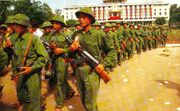
North Vietnamese army cadets in 1971
country to push back the Americans and South Vietnamese. In the 1960s, the United States increased its military presence in South Vietnam to deter the North Vietnamese threat. As the war progressed, the Viet Cong and the NVA launched the infamous Tet Offensive in 1968 and overran all major cities in South Vietname during the anual Vietnamese holiday of Tet. The offensive was repeled, but the American public was demoralized from seeing how the United States was unable to adequately protect South Vietname. Under pressure from anti-war protesters and having already given ground to the communist Sino-Soviet Union, President Richard Nixon signed the Paris Peace Accords in 1973 officially ending the war and splitting Vietname in two; communist north and democratic south.
Afghan military intervention
In 1979, the Islamic insurgent group known as the Mujahideen launched an insurgency in Afghanistan in an attempt to overthrow the communist-back socialist republic that dominated the country. The Soviets couldn't sit by and let this happen and so a large invasion force of 480,000 troops was deployed into the country in an attempt to supress the uprising. In 1981, Chinese Soviet forces poured in from the eastern parts of Afghanistan and helped secure control over the eastern provinces of the country. Military efforts worked and the Mujahideen was forced up into the mountains where they waged a guerilla war all the way into 1983 which forced the war into an effective stalemate. Seeking to break the stalemate, Chinese Soviet forces poured into Afghanistan from the country's eastern provinces and began pushing the Mujahideen further up the mountains. Soviet Russian forces then began to deploy Mil Mi-24 gunships and began snuffing out the Afghan insurgents.
The Mujahideen began to lose the war effort and the United States had attempted to funnel aid to the Afghan insurgents with new stinger missiles. Soviet spies however, caught wind of this and the United States had been exposed and was thus forced to cease all aid. Without American assistance, the Mujahideen war efforts failed and the organization sued for peace with the Afghan socialist government and by 1988, they surrendered and officially disbanded that same year. Socialism began to spread further across the Middle East and South Asia as a result of the communist victory in the war and Syria became an official socialsit state in 1989.
Reformation and modernization
1989 Eastern bloc crisis
In 1989, revolutions had began to sprung up across the entire Eastern bloc states. The Warsaw Pact governments had been accused of corruption, erosion of rights, supression of freedom of speech and religion and various other violations by the peoples of the member states and thousands protested demanding equal rights, political reforms, and the democratization of Eastern Europe. At the time, Jiang Zemin was the premier and he began to see the spread of the revolutions head to China where student groups protested with the same demands as their Eastern European counterparts. Xiang had pressured his administration and the Soviet government into taking violent military action against the protestors believing that they were threatening th destabilize the dissolve the Sino-Soviet Union and they needed to be stopped immediately. On June 4th, 1989, Chinese Soviet forces were deployed to Tiananmen Square in Beijing and this lead to the deaths of 180-218 protestors and hundreds more wounded.
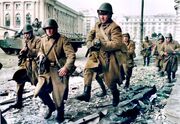
Romanian Communist soldiers in Bucharest during the uprising, December 12 of 1989
Back in Eastern Europe, dissidents and foreign journalists reported this to protestors in the Eastern bloc and further protests errupted and even spread into the Russian SFSR with many calling for the resignation and arrest of Jiang Zemin and his cabinet on charges of corruption and murder. In Romania, protestors went a step further and began storming the capital of Bucharest and occupied city taking over government buildings and even occupying tanks and military vehicles. Zemin continued to use violence and had the Warsaw Pact forces storm the capital and take out the revolutionaries by force. This lead to a violent battle resulting in the deaths of hundreds of Romanian protestors and the capital to be retaken. The entire union was put under martial law and instability plagued the nation. Desperate to maintain order, Soviet Russian politican Mikhail Gorbachev rallied support and campaigned for mass political reform, political rights and freedoms, and modernization of the nation. This won him many support and in 1990, he was elected as the General Secretary of the Communist Party and began to take actions against Jiang Zemin. The Communist Party began to heavily regulate Zemin and arrest many members of his administration and put military commanders and officers who participated in the Tiananmen Square and Bucharest protests on trial and had them executed.
1991 coup and Gorbachev era
On August 19th, 1991, factions of the Soviet People's Armed Forces loyal to Gorbachev and loyalist factions of the Communist Party, staged a military coup during Jiang Zemin's trip to Moscow to negotiate between his administration and the communist party. While he was there, military forces stormed the capital city and put Moscow on lockdown and enforced martial law on the city. News broadcasts quickly broke out and footage was shown of tanks and armored convoys pouring into the city and storming the Kremlin and other government buildings across the city, Jaing Zemin was found and arrested by the military and factions of the army loyal to him were stopped and arrested and Gorbachev was eventually voted into power via an emergency election by the communist party on the 21st of the same month. After taking office, Gorbachev addressed the nation on the 22nd declaring that Jiang Zemin was arrested and would be put on trial on charges of conspiracy, corruption and abuse within his office, and for instigating the deaths of thousands of civilian protestors during the 1989 revolutions. Gorbachev also signed and ratified the New Union Treaty, massively reforming the Sino-Soviet Union and granting more aoutonamy and freedoms to the various Eastern bloc states.
As a result, the Warsaw Pact was finally stabilized the communist bloc was reformed and reorganized into a more sufficient and stable system. The goals of the protestors were also met as well with new political freedoms being allowed and one-party rule being effectively abolished in favor of new political parties to offer more freedoms to the people of Eastern and Central Europe. Many of the communist parties in the Eastern bloc states were dissolved such as the ones in Poland, Hungary, Romania, and the Eastern European states of of Latvia, Lithuania, and Estonia. Gorbachev also began reforming the economy as well, legalizing private business and lifting some restrictions on companies to allow them to grow and expand. As a result, the Soviet economy began to rebound after nearly a decade of stagnation and the 1990s was an era of modernization and economic growth as a result of the New Union Treaty and new economic policies. In 1992, the Sino-Soviet Union began negotiations with the European Community and the United States which resulted in restored diplomatic relations and the near-conclusion of ideological and political tensions effectively ending the Cold War and putting the USSSR on a new and bright path down the line into the 21st century. The internet was allowed into the country and the new technologies helped advance the nation further into the future.
Modern era and the 21st century
Conflicts in the Caucasus
In 1995, unrest had rocked the Russian republic of Chechnya down in the Caucus regions. The native population found itself in upheaval over decades of communist policies and advocated for secession from the Sino-Soviet Union citing years of anti-religious policies and oppression at the hands of the officially atheist communist regime. As part of his reforms, Gorbachev also signed into law new legislative acts declaring religious freedom and inherit right and reforming the state constitution and making the communist party follow through on the consitution and was forced to enforce it and the ammendments. The Chechens however, were still not pleased
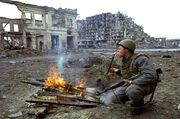
A Soviet-Russian soldier smoking admit the ruins of Grozny in 1996
and continued to protest as part of the larger unrest in Central Asia over the same issues, lack of religious freedom and the communist regime's treatment of religious citizens in the Central Asian republics. In December of 1995, Chechen militant stormed the capital fo Grozny and declared the establishment of the Chechen Islamic Republic and announced on live tv the abolition of communism in the country and the secession from the Sin-Soviet Unionl. In response, a force of over 240,000 soldiers was sent into the country and this lead to the outbreak of the Chechen War. The war continued for most of the remaining 90s and saw mass devestation and destruction be left behind and Chechnya reduced to a war-torn state. On November 18th, 1998, members of the Central Military Commission gathered and declared that Chechnya would remain under Soviet control and that martial law would be declared and a military presence would be established until the insurgents had given up and announced their surrender. An insurgency would go on for the next three years until November of 2001 when the last Chechen army group surrendered and the war came to an end. Chechnya was rebuilt and today it's been restored to both pre-war conditions and as a modern state, though an low-level insurgency contiues to this day.
War on Terror and Afghanistan
On September 11thm, 2001, the World Trade Center in New York City was destroyed by hijacked airliners belonging to members of the Islamist terrorist organization, Al-Queda and was orchestrated by Osama Bin Laden. The attack was in response to the presence of American soldiers on Islamic soil, primarily Saudi Arabia, and this lead to the instigation of the War on Terror as coined by then president George W Bush. By 2001, Boris Yelstin was president and he took part on the War on Terror after the infamous apartment bombings in Moscow. Islamic militants began to spring up across the neighboring state of Afghanistan and this lead to a military intervention in support of the socialist Afghan government against the Afghan Islamic Party starting in April fo 2002. Yelstin later resigned as president that same year and was succeeded by Dmitri Medvedev who sent 480,000 troops to Afghanistan to supress the
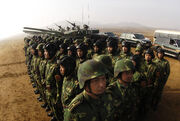
A Chinese armored division in Afghanistan, 2010
Afghan Islamic Party and their insurgency in the country to maintain the socialist regime in the country. From 2001-2002, the initial invasion of the country saw the destruction of all known institutions and organizations affiliated with and/or supportive of islamist insurgents and groups and the pruge of the government and its reorganization to one filled primarily with socialist hardliners.The Soviet military intervention in Afghanistan was later shared by the United States and its NATO allies which saw the two superpowers working together for the very first time and was an iconic moment.
The Soviet forces focused on monitoring the terrain and assisting American forces in located Afghan islamist cells and hideouts while Soviet Russian and NATO officers advised and trained Afghan soldiers to help arm them for the task of defending the country themselves. Soviet Russian and Chinese officers were often viewed favorably by the Afghan army recruits in comparison to their American and NATO counterparts due to Cold War era ideological tensions remaining active despite its end in 1991. Chinese forces played a major role as part of many counter-insurgency operations alongside American forces and Russian fighters helped play a major role in bombing and air campaigns along with other American and NATO forces.
Military intervention in Syria
Main Article: Soviet military intervention in Syria

Russian soldiers prepping for an operation in Syria, 2016
Sometime in 2010, protests broke out in Syria over the failed policies of Bashar al-Assad which lead to a decline in agriculture and the mass migration of rural farmers and citizens to the cities which resulted in housing issues and tensions between rural and urban residents. The Syrian government was also ciritcized by many of its citizens not only for failed policies, but also history of political repression, silencing of the opposition, and authoritarianism by the nation's socialist regime. This lead to the oubtreak of a civil war in 2011 and it soon spiraled out of control as the Syrian government and its forces was soon stretched thin across the country fighting various different factions. Seeking to perserve Assad's government and the socialist regime, the Sino-Soviet Union conducted a military intervention in April of 2014 and began sending in troops and supplies into the country with the intent on removing the influence and strength of jihadists elements, particulary the Army of Conquest and Al-Queda affiliated groups, networks, and cells.
The international community has often decried the military intervention as a Cold War tactic of attempting to retain the socialist regime in Syria to act as an ideological buffer against the United States and have cited the various human rights abuses and crimes that were committed by the Assad-regime and the previous presidents such as extortion, torture, censorship, and authoritarian messures against the country's people. The Sino-Soviet Union has dismissed such accusations citing that if the regime were to fall, then it would be replaced by an islamist dictatorship or Syria would collapse into various warring states and factions as part of a power vaccume. Since the intervention started in 2014, around 6,893 jihadist soldiers have been killed by Soviet airstrikes and Syrian attacks supported by the Soviets while 5,194 civilians have also died during the operations.
2014 Eastern Bloc crisis
Main Article: 2014 Eastern Bloc crisis
Sometime around November of 2014, mass protests were staged and held across the entire Eastern Bloc covering all major cities of the Warsaw Pact. The crisis began when it was revealed that the governing body of the Warsaw Pact had tooken a bail from the Sino-Soviet Union and elected officials in the organization had formed policies that brought the Eastern Bloc states closer to the Soviet mainland and reports came in of government officials and heads of state enforcing laws and policies that favored the Soviet Union ahead of their individual nations. Protests had began to spring up, but they were met with fierce resistance from the WP governments who used police and brute force to violently break away and subdue protesters which lead to the outbreak of even more protests across Eastern and Central Europe. Other issues was with economic regulations that the state still had over the Eastern Bloc economies and the continued censorship and regulation of the internet and the overall spread and flow of information across the Warsaw pact as a whole. Threats had emerged from the Soviet central government demanding that the Warsaw Pact governments solve the crisis or the Soviet Union would send in military forces to occupy nearby rebellious states and assist in maintaining order throughout the region which caused many activists to further their protests citing the violations of Eastern Bloc sovereignty that was established by Gorbachev during his administration in the 1990s and early 2000s.

Russian soldiers occupying a military base in Ukraine, 2014
Protests spread further beyond the Eastern Bloc and into the neighboring Soviet republics of Eastern Europe with activitsts their motivated enough to call for a new treaty reforming the Sino-Soviet Union into a confederation and to allow the republics to join the Warsaw Pact as independent automonous states rather than republics of the Soviet Union. In response, First Secretary of the Ukranian SSR, Vikto Yanukovych, had enforced martial law and put the capital city of Kiev and other major cities on lockdown and used military police to disperse protesters, only to have the people rise up in a revolution and forced the Russian SFSR to send in troops and occupy ethnic Russian regions of Ukrain and the National Assembly eventually convinced the Ukrainian State Assembly to impeach Yanukovych and was succeeded by Petro Poroshenko who negotiated with Vladimir Putin and convinced the protesters that their demands were met, but it would only last for a short period of time. The other republics in Eastern Europe eventually had some of their demands met in exchange for them remaining in the union and stability was brought back to the country, but the Eastern Bloc was still in turmoil. In response to many of the violent protestors and reports of ethnic tensions and violence in Eastern Europe, Soviet Russian soldiers were deployed and occupied various regions that contained majority ethnic Russian populations and pressured the Euromaiden protestors into standing down admist threats of invasion.
Crisis in Eastern Africa
Main Article: East Africa Crisis
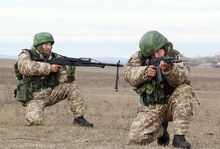
Soviet soldiers conducting a counter-terrorist operation in northern Somalia, 2013
In 2003, the United States and NATO forces launched an invasion of Iraq and overthrew the Baathist regime in Iraq, causing outrage from the communist bloc who accused the invasion of being an "example of western imperialism and capitalist exploitation" and stated that the invasion of Iraq would put the stability of the Middle East and even Africa at risk of falling apart. The fear was initially dismissed, but it would later come true as sometime in 2007, an Islamist militant group known as the Islamic Army for the Liberation of Somalia, shortened to the Islamic Army of Somalia, staged an uprising in Mogadishu which ended in a victory for the communist regime. Despite the victory however, it sparked a civil war between the communist regime and the Islamic army who received support from other Islamist movements and militant factions.
The Somali Socialist Republic would later have to fight against both Islamist factions and the separatist movement of Somaliland, a self-proclaimed state in northwestern Somalia. This eventually convinced the Ethiopian People's Republic to send in troops, but they were later a victim to American-backed anti-communist insurgents who staged an uprising to "liberate the people and nation of Ethiopia from marxist tyrants". Other insurgents included anarchists which saw a stateless society and eventually turned into third front in the war. Seeing the chaos across East Africa, Soviet troops were deployed to the region to train local forces as well as conduct anti-insurgency operations to support the communist governments of the region. In 2012, Soviet Spetsnaz were deployed to the Ethiopian-Somali border and took part in an counter-terrorist operation which resulted in the destruction of an IAS base and the death of one of their leaders, Taaj el-Baccus. Since 2015, airstrikes and other military operations have been conducted against opposition territories by the Soviets.
North African insurgency
Main Article: North African insurgencies
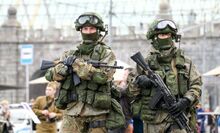
Soviet soldiers guarding a checkpoint at the Libyan-Egyptian border, 2016
The Arab Spring of 2011 had ruptured the Arab world and presented a major problem to the communist regimes of the North African states. Countries like the Libyan Democratic People's Republic and the Egyptian Socialist Republic found themselves threatened by anti-communist activists. As the Arab Spring progressed however, the slow progress of reform and even continued oppression by the communist regimes promoted large factions of the opposition to join islamist movements resulting in an insurgency in Egypt following the 2012 Cairo bombing. The event convinced the Soviet Union that the communist regimes needed support, and so aid was sent in by November of 2012 in the form of military advisors and special forces to conduct counter-terrorist operations.
The first major event was in Cairo where Soviet military advisors had helped aid the socialist regime in Egypt to suppress and eventually crush an attempted coup by civilian rebels and dissident factions of the army. Afterwards, martial law was declared across the country and Soviet gunships were seen attacking rebel bases and holdings across Egypt. In Libya, the communist regime was propped up by the Soviets while a western-backed political faction known as the Libyan Democratic Republic had took over portions of northwestern Libya promoting the beginning of a civil war in 2014. In 2016, the Sino-Soviet government had accused Western Bloc nations of promoting terrorist activity in North Africa citing reports of American weapons being found in insurgent bases by Soviet and local forces.
Politics
Main Article: Politics of the Sino-Soviet Union
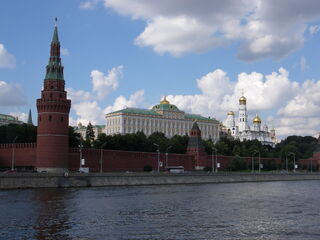
The Moscow Kremlin, one of seats of government
The Sino-Soviet Union is a single-party federal republic governed by the ideology of Marxist-Leninist form of communism according toofficial documents and the charter of the nation's communist party. In reality however, the country is a socialist state and adheres to socialist economic and political theories. The nation's constitution states that the nation is a socialist state and adheres to its theories to establish an equal and fair society for all Soviet citizens.
Government
Main Article: Government of the Sino-Soviet Union
The Soviet central government is split up into three branches;
- Legislative: The National People's Congress and the Union of Nationalities
- Executive: Premier of the Sino-Soviet Union and the administration
- Judicial: Supreme Court and Regional Courts of the Sino-Soviet Union
The Sino-Soviet Union is a single-party socialsit state governed by the Communist Party being the central governing body and institution of all forms of government and politics within the country. Only the communist party is allowed to run in elections and other political parties and organizations affiliated with or endorsed by the communist party may run and contest in national elections. These other organizations and entities are often trade and labor unions and other workers parties and unions. Around 84% of the seats of the National People's Congress are held by the communist party along with 72% of the Union of Nationalities while the rest in both houses are held by various other approved parties. The remaining 28% of seats in the Union of Nationalities are comprised of various other political parties approaved by the communist party which have formed a coalition in the government known as the Representative Bloc. The bloc is made up of political parties that represent the various republics in regions across the nation such as Eastern Europe, the Causcus Regions, Central Asia, and China to represent the various republics and to perserve the union.
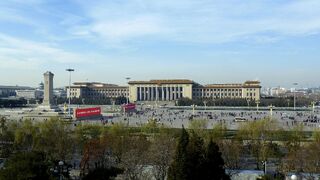
Great Hall of the People, officials meeting place of the National People's Congress in Beijing
The Premier of the Sino-Soviet Union is the official Head of State and exercises executive power alongside the General Secretary of the Communist Party. The Premier is also the head of all diplomatic and foreign affairs of the country and is the commander-in-chief of the country's military. The General Secretary of the Communist Party serves as the head of government as well and the leader of the communist party and all of its committees and governing bodies. The National Assembly is the bicameral legistlature of the government and is made up of 280 seats with the communist party holding 84% of while the remaining 16% are held by the United Soviet Front, which represents the various other political parties approaved by the communist party and its central committtee.
The National People's Congress is the upper house of the National Assembly and is the largest in the world with a total of 2,987 seats. It's comprised of elected representatives from the various republics who all elect eight senators to represent them in the congress. The NPC is officially and according to the state constitution "the upper house of the National Assembly meant to oversee all domestic and foreign affiars" and is in charge of all internal affairs as well from laws, bills, and decleration of war and other political actions. It's overseen by the Chairman of the National People's Congress which is the third most important position in the government. Below the NPC is the Union of Nationalities which is the domestic legislative body and acts as a form of representatives to the various nationalities and republics of the Sino-Soviet Union and the two bodies make up the larger National Assembly. The assembly is ran by carious committees, primarily the Central Committee of the Communist Party and they often have the final say in politics and all matters of government, though their authority has been restricted in recent years.
Foreign Relations
Main Article: Foreign Relations of the Sino-Soviet Union

Foreign Ministry building in Moscow
The Sino-Soviet Union has a rouge history of foreign affairs not only due to the Cold War, but also the shere size of the country as wellas its single-party socialist government and system has lead to a history of many unstable foreign relations, but has become more stable in recent years despite increase in hostilities with the United States and the Western Bloc states. The Sino-Soviet Union has been able to re-establish stronger and more warmer relations with the Eastern Bloc states following the Eastern Bloc Reformation Act of 1991 which granted full autonomy and independence to the Warsaw Pact member states ending their status as satellite nations of the Sino-Soviet Union. The USSSR has the msot friendly ties with many Middle Eastern nations such as Afghanistan, Syria, and Iran due to their socialist governments and ideological nature and many African states are also warm towards the Sino-Soviet Union. Relations with the United States have improved since 1989 and into the 2000s, but Cold War-era ideological tensions have resurfaced in recent years due to the policies and actions of Vladimir Putin as Premier of the country. The Ministry of Foreign Affairs is responsible for handeling the country's international relations and is headed by the Minister of Foreign Affairs who is the diplomatic leader of the country and represents the Sino-Soviet Union in foreign affairs. The country is one of the five permanent members of the United Nations Security Council and plays a major role in global politics and affairs. The country is the leading member of the Warsaw Pact, World Trade Organization, and the Collective Security Treaty Organization to show off its global military power and might worldwide.
Human Rights have often been a long running issue for the Sino-Soviet Union since its formation back in 1946. The nation's communist regime has been heavily ciritcized by both foreign watchdog groups and human rights organizations as well as homegrown activists and political dissidents for its oppressive policies and history of what Amnesty International calls "human rights catastrophes" from Stalin's reign to Mao's purges and Jiang Zemin's massacres in China and Eastern Europe all of which have lead to the deaths of over 70-80 million people over the course of the 20th century. The Ministry of Foreign Affairs and the Central Committee on Domestic Security criticize such actions and dismiss organizations such as the American-based Freedom House as "western propaganda outlets", but dissidents within the country have often accused the regime of human rights abuses and have escaped the country to work with such organizations to democratize the country.
Military
Main Article: Soviet People's Armed Forces
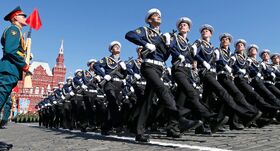
Soviet Russian soldiers during the Victory Day Parade in 2014
The Soviet People's Armed Forces is divided into five branches; the Ground Forces, Navy, Air Force, Rocket Forces and Airborne Troops. It's mandatory for all Soviet males ages 18-35 to serve at least 12 months in the armed forces, a law that is debated amongst members of the National Assembly, but not the communist party. The armed forces are headed by the Central Military Commission and are lead by the General of the Staff who heads the commission. The Sino-Soviet Union possesses the world's largest standing army of 6,350,920 active duty soldiers and holds the largest stockpile of nuclear weapons in the world as well. The country has its own indigenous arms industry and produces almost all of its own weapons with only a small handful ever needing to be improted into the country, mostly experimental weaponry, and has been the world's top arms supplier since 2001 surpassing the United States that same year. The nation's defense budget is at around $718.4 billion making it the largest in the world and in all of Europe. The Soviet People's Armed Forces has often taken the role as the leading nation when it comes to peacekeeping missions and personnel next to the United States and the Sino-Soviet Union has the second largest number of military bases around the world surpassed only by the United States, one of the few positions that the US hasen't been surpassed by.
Administrative Divisions
Main Article: Republics of the Sino-Soviet Union
According to the Constitution of the Sino-Soviet Union as of 1991, the country is a federal republic comprised of 27 republics. In accordance with the constiution, each republic is granted a form of autonomy similiar to that of a US state in that they are allowed to pass and make their own laws and their own internal affairs and matters like that of a sovereign state as long as they don't interfere with the wills of the communist party and/or the central government. On June 12th, 1991, the communist party passed the Soviet Republic Autonomy Act which granted the republics the right to their own sovereignty and are allowed to run their own affairs. Each republic is governed by a First Secretary who is elected by the republic's regional parliament in a national election and the final victor is decided by the republics' central electoral committee.
The Soviet Federative Republics of Russia and Mandarin were divided into various autonomous republics and oblasts based around various ethnic groups per region as part of the 1991 constitutional referendum. This is to assure that various ethnic groups have full control over their communities and will be left to their own affairs as long as they don't interfere with the actions of the communist party nor the central government. The Mandarin SFSR and Russian SFSR are the most economically developed, populous, and largest republics of the entire country and are often considered the backbones of the nation as a whole due to their size, wealth, and their political power as both are the homes of the nation's capitals of Moscow and Beijing.
Human rights
Main Article: Human rights in the Sino-Soviet Union
According to the constitution of the Sino-Soviet Union, citizens of the union are allowed the rights of freedom of speech, freedom of religion, freedom of the press, right to assembly, freedom of protest and the right to a fair trial. Despite these rights however, these rights were rarely ever observed and were frequently violated by the communist regime. Ever since the creation of the union, the country has had some of the worst records when it comes to human rights with frequent reports of state murder, public execution, religious and ethnic persecution, mistreatment of workers and even slavery have surrounded the Soviet Union's history. The country was first lead by Joseph Stalin and Mao Zedong who lead to the deaths of up to 84 million people total in the country with their policies of population control, five year plan, and the cultural revolution. Under Stalin, up to 14 million Chinese citizens had died under his reign due to his famine policies in an attempt to starve out remnants of the Chinese nationalists and Mao killed up to 70 million people throughout his time as both premier and general secretary.

A Free Tibet activist with a sign showing Soviet Chinese atrocities in Tibet, 2008
The Cultural Revolution has frequently been called the worst era for the Sino-Soviet Union as the entire country was purged of any elements of pre-communist culture, iconography, art, literature, ect and many across the entire nation were purged from peasantfarmers to the highest ranking members of the communist party. Following Mao's death in 1970 at the hands of factions of the military, the country fell under the control of Leonid Brezhnev who had began the process of de-maoization which lead to increase of Russian influence in China and the increase of Soviet military power in the world with the army being reformed to be loyal only to the Sino-Soviet Union and not the communist party. Despite this however, his administration saw economic and social stagnation in the country and it was marked by food shortages in the rural countryside of the Chinese republics as well as riots in the Tibetan SSR which lead ot a severe crackdown in the region and the start of an anti-religious campaign in the country which lead to the arrests of tens of thousands of Soviet Chinese citizens, mainly Tibetan buddhists. In 2008, Tibetan monks and activitsts protested in the Tibetan SSR during the 2008 Beijing Olympics to direct international attention towards human rights abuses and violations in Tibet which was heavily censored by the state-controlled media, but did make headlines during and after the olympics.
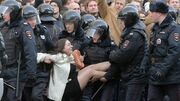
A young Russian girl is arrested during a protest in Moscow, 2017
Religious freedom has been a constant issue for the Sino-Soviet Union since its formation with state atheism having been enforced from 1946 until Gorbachev's reformations in 1989. During that time, religious institutions were severly regulated and many religious sites and temples were either destroyed or taken over by the central government and repurposed as factories or even propaganda centers where films such as the Wrath of the Tsar and Heavan's Mandate are frequently broadcasted in. Many of the Eastern European Soviet Republics such as the Russian SFSR, the Ukrainian SSR, and others have established Eastern Orthodox Christianity as the official state religion in the republics while other christian denominations have been heavily regulated and discriminated against by the communist governments in the specific republics. Political freedoms remain some of the worst in the world with the media being under the control of the state and the Ministry of Public Domain while certain websites are banned and replaced with state altered versions of them or are heavily regulated so dissident content doesn't get into the country's servers and its citizenry. Protests are allowed according to the constitution, but most in recent history have been met with violent response from the central government and riot police are frequently sent in and police brutality is often the common result. The communist party is also the only legal political party and other political parties are limited to their individual republics and not the entire nation. Often times critics and opponents of the communist party are branded as conspiritors by the Ministry of Internal Affairs and are arrested on charges of conspiracy to undermine the Sino-Soviet Union.
Demographics
Main Article: Demographics of the Sino-Soviet Union
Languages
The Sino-Soviet Union has a large collection of languages that are spoken across the cross-continental superstate. The Russian and Traditional Chinese languages are the official languages of the state and are both spoken and understood by the vast majority of the country's citizens, but the nation has a grand total of 337 spoken languages across ethnic, regional, and national lines making the country the most diverse linguistic nation in the world which helps maintain the union's status as the most multicultural and diverse nation in the world. Russian is understood by 77% of the entire Soviet population with 63% reportedly speaking it in their daily lives. The Eastern European Republics along with the Russian SFSR and even the Kazakh SSR as well. Mandarin is spoken primarily down south in the Chinese Republics and is understood by a majority of the population down there. 68% of Soviet citizens reportedly understand Mandarin and 35% use it in their daily lives with the Mandarin SSR being the most Chinese speaking Republic in the entire country.
Other prominent minor languages are Ukrainian, which is one of the official languages of the Ukrainian SSR next to Russian and the languages of both the Baltic States and Central Asia which vary upon each republic and are always shared alongside Russian. The Chinese Soviet Republics have a similar system in that many of the republics have official and widely spoken languages next to Mandarin which is both official and mandatory for Chinese Soviet citizens to speak and understand alongside Russian. Other languages are mainly those that vary from various ethnic and religious groups, though many of these languages have been threatened in recent years due to Sovietization policies from the 1970s which have continued into the modern era.
Ethnic groups
The Sino-Soviet Union is the most ethnically diverse nation in the world. Due its size and scale across Eurasia, over 75 ethnic groups were officially listed in the recent 2012 census. Han Chinese are the largest ethnic group in the entire country with 63% of the population being ethnically Han. Russians come in second place at around 34% of the total population and rest vary from various Eastern European and Central Asian states. The Chinese republics alone hold most of the minority ethnic groups who are represented in the National Assembly as part of the Representative Bloc and form various political factions such as the Baltic State Alliance, Ukrainian People's Pact, Central Asian Coalition, and the largest being the Chinese Minority Rights Association.
Religion
According to the Constitution of the Sino-Soviet Union, freedom of religion is a guaranteed right and all Soviet citizens have the right to practice or not practice any known religion. Despite this however, the Soviet Union has had a long history of anti-religious policies dating as far back as the Russian Revolution in 1917. The Sino-Soviet Union is officially a secular state and institutes a strict separation of church and state. Christianity, Islam, and Buddhism are the three major religions and are one of the five religions recognized by the Soviet government. Due to decades of policies of state atheism by the communist regime and various anti-religious campaigns, around 48% of the Soviet population is unaffiliated with most of them being located in China. Christianity is the dominate religion in the country with around 32% of Soviet citizens identifying as Christian in the 2012 census with the largest Christian denomination being Eastern Orthodoxy. The Russian SFSR and the Eastern European Soviet republics are the most religious with the Ukrainian SSR and Western Russia in recent years being referred to as the Bible Belt of the union.
Islam is the second largest religion making up 14% of the total population. Central Asia and East Turkistan hold the largest concentration of muslim citizens along with the Caucus regions in the Russian SFSR. Islam has been the source of many tensions between the communist government as Islamic institutions and organizations have been heavily regulated in recent years to combat the spread of Islamic fundamentalism and state atheism policies have been reintroduced in the Central Asian and Uyghur SSR. Buddhism is the third largest being at around 3% of the population, with the largest concentration being located in the Tibetan SSR. Various minor religions exist such as Hinduism down south and a small, but prominent community of Jews also exists in the country with most of them being concentrated up north in Russia. Religion's role varies upon the culture of the various republics, but it's been an ire for the communist government for years regardless with tensions still remaining high.
Healthcare
The Sino-Soviet Union has instituted a policy of universal healthcare to all of its citizens and all healthcare activities are supervised and overseen by the Ministry of Health. The Sino-Soviet Union has the largest numbers of hospitals, physicians, and healthcare workers per capita than any other country in the world, but it's often been restricted in practice due to mandatory registration. The Constitution states that all citizens are to be given free healthcare and is often carried out in practice, but has been slightly reversed in recent years due to renewed tensions with the Western Bloc as well as the ongoing political crisis in the Eastern Bloc.
Education
Education in the Sino-Soviet Union is provided for by the state and is overseen and managed by the Ministry of Education and Science. Around 4.8% of the country's GDP is spend on education and has the largest number of educational institutions in the world as well as one of the highest rated education systems in the world. Literacy rate stands at 99.8% of the total population and the Soviet Union is the top destination for international students surpassing the United States. 68% of Soviet adults have attained a tertiary education, making it the highest in the world.



